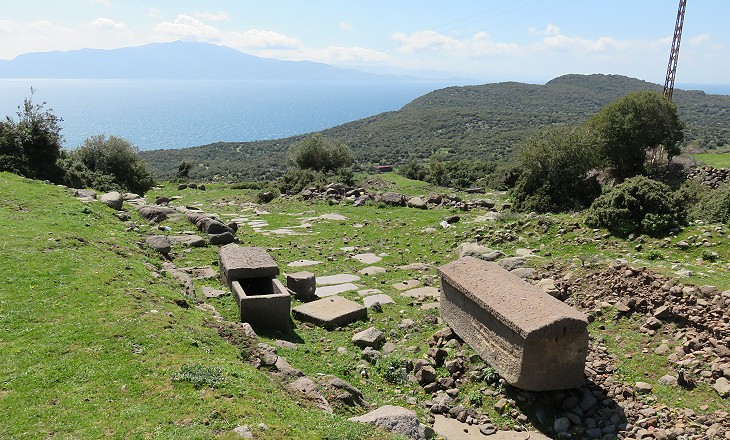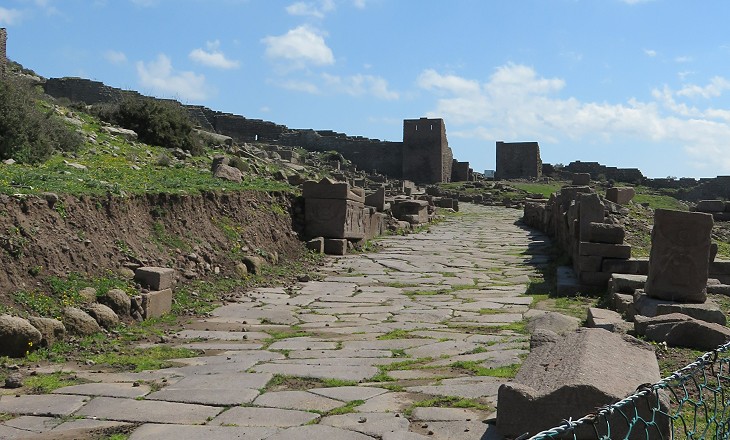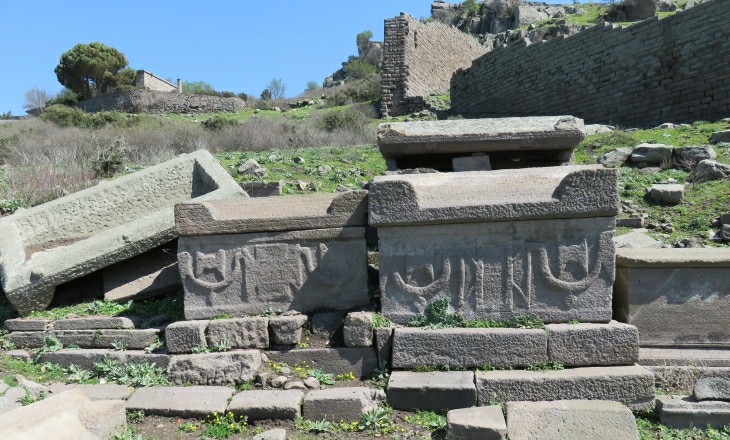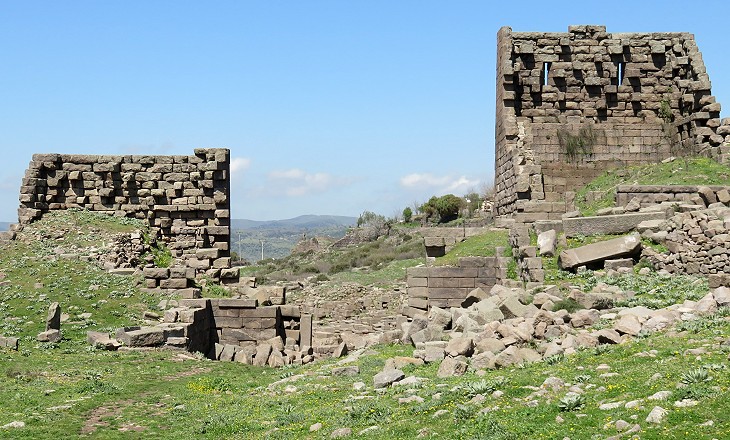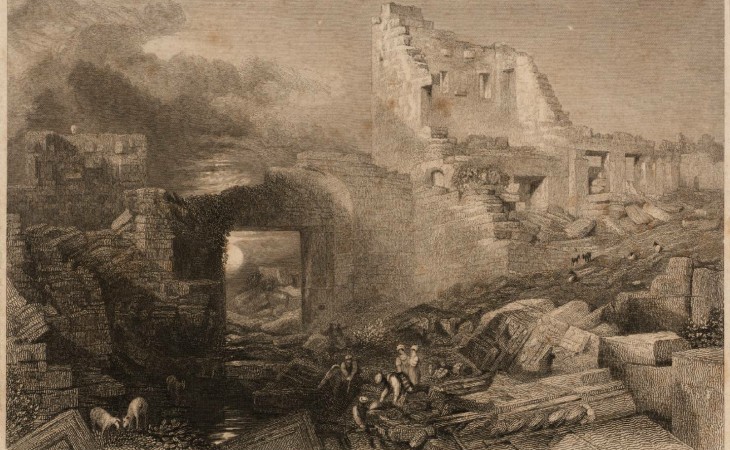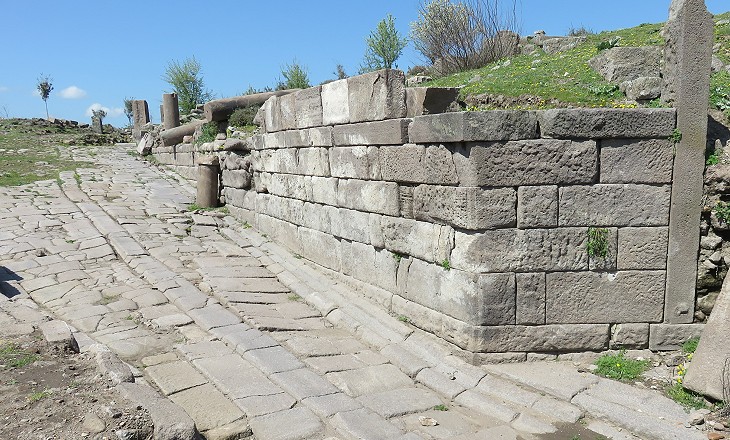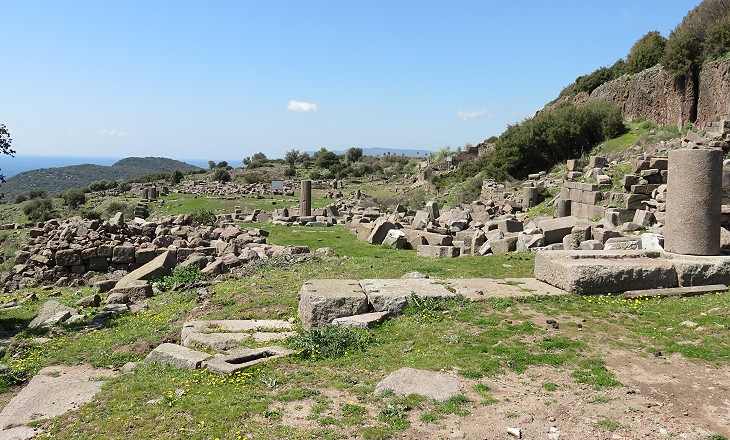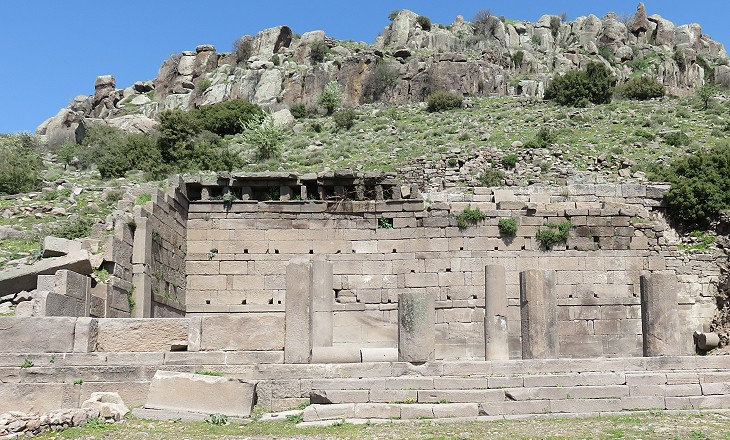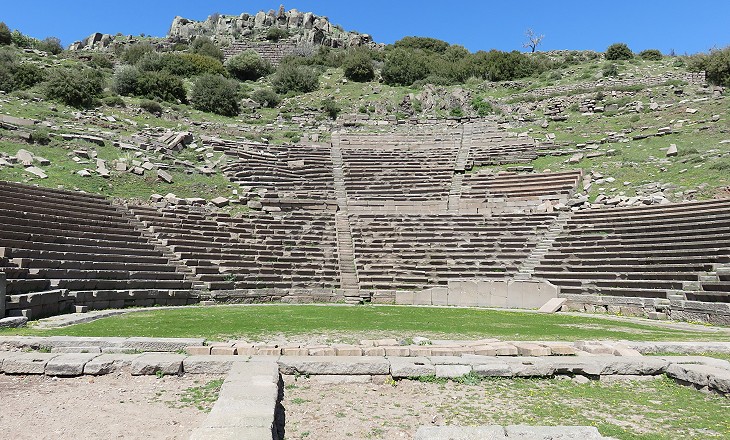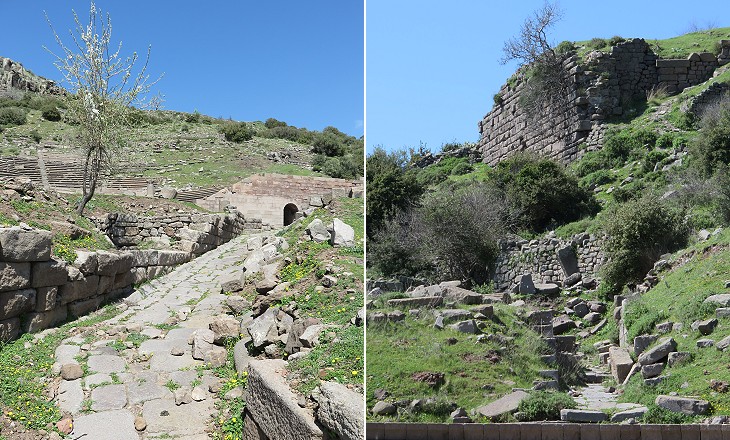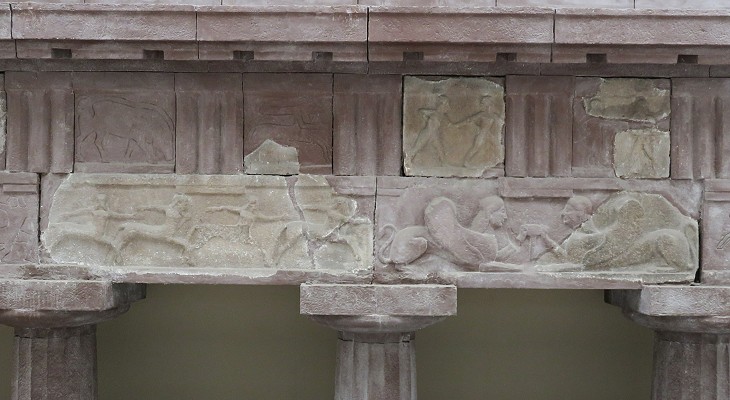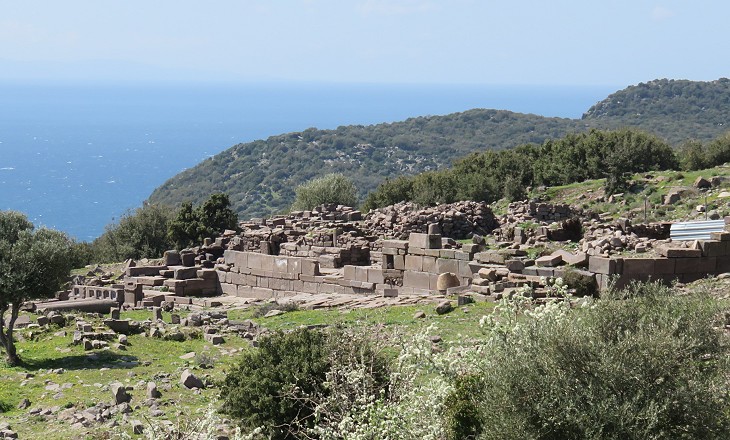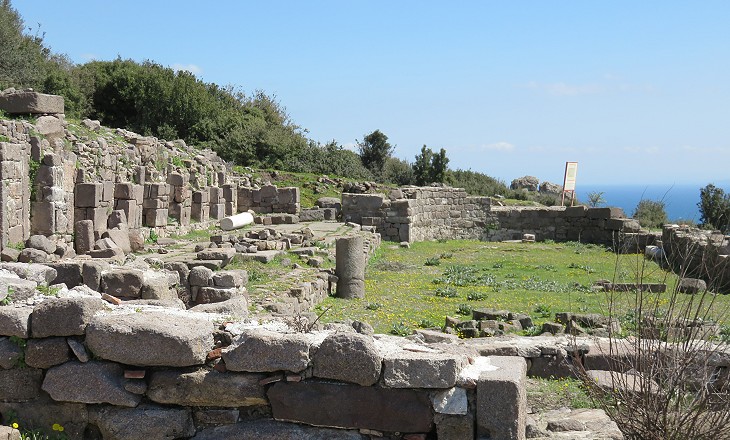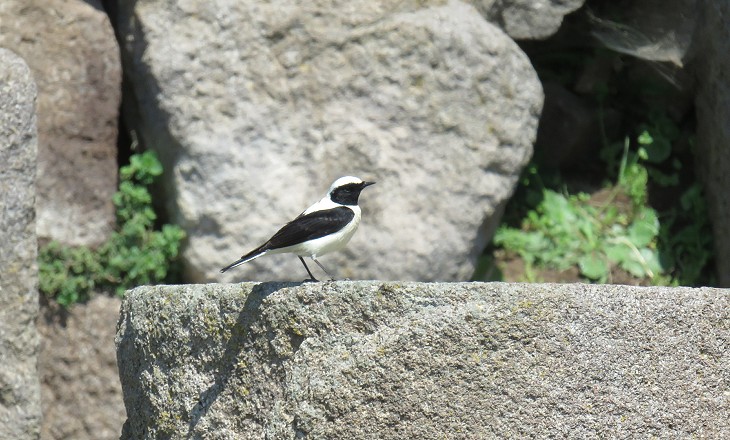  What's New! Detailed Sitemap All images © by Roberto Piperno, owner of the domain. Write to romapip@quipo.it. Text edited by Rosamie Moore. Page added in May 2015. |
 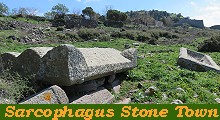 - Assos - The Lower Town - Assos - The Lower Town(sarcophagi in the Lower Town) You may wish to read page one first.
At about six miles' distance from Behram, the ancient Assus or Assos, we left the sea-side and ascended through wild rocky scenery, rich in useless vegetation. The approach to the ancient town is very imposing: we entered a little wood of shrubs, which I found thickly interspersed with the stones and lids of sarcophagi. Charles Fellows - Journal Written during an Excursion in Asia Minor in 1838
I then entered the Via Sacra, or Street of Tombs, extending for miles. Some of the tombs still stand in their original beautiful forms, but most have been opened, and the lids are lying near the walls they covered, curiosity or avarice having been satisfied by displacing them. Occasionally in the line of tombs are circular seats, as at Pompeii; but these ruins are on a considerably larger scale than those of the Roman city, and many of the remains are equally perfect. C. Fellows
Several sarcophagi are highly ornamented, and have inscriptions (..). The material of which the town was built not being fine, the sculpture is not of much value (..); the usual length of the sarcophagus is from ten to twelve feet. (..) The Anglicised word sarcophagus is a Roman one, of not very early date. (..) Pliny says that a peculiar stone, found in the territory of Assos, has the property of wasting the bodies entombed in it; hence the term sarcophagus, meaning 'flesh-eating'. C. Fellows The stone mentioned by Pliny was alum, which is characterized by a degree of astringency. It was used for dyeing and tanning. Alum mines at Foca, not far from Assos, were used by the Genoese in the XIIIth/XVIth centuries.
The Lower Town was protected by walls which joined those of the acropolis. The imposing gate on their western side was built in the IVth century BC, most likely by Hermias, who ruled the town before the Persians restored their control over the region.
In 1881-83 the site of Assos was dug by the Archaeological Institute of America. The object of the excavations was chiefly to find reliefs, statues, coins, etc. which were shipped back to the Institute in Boston (640 items, mainly coins, are currently on display at the Museum of Fine Arts - external link - you may wish to see a detail of a relief - it opens in another window).
The Lower Town was developed taking into account the slope of the hill, which at points was (and in part still is) rather abrupt. Notwithstanding this aspect, the main buildings of the town were aligned along an almost straight east-west axis.
A very long agora was the heart of the Lower Town; it had a temple at its western end and a bouleuterion, a hall where the city council met, at the eastern one. The site suffered at the hands of the AIA expedition, and not just from the rapidity of the work. For example, Bacon (a leading member of the expedition) repeatedly decried people taking stones from the ruins: "It makes one's blood boil to think how this grand old city has been devastated within the last 50 years! The Turkish government has been carting away cut stones, and every little village in the neighborhood comes here for building material" and "As fast as we uncover a wall of dressed stone the Turks are apt to demolish it! The gypsy smiths steal all the iron clamps as fast as we expose them (..). In 10 years it won't be much use coming here to see Greek ruins!" Mark Rose - Archaeology (a publication of the AIA) - Volume 61 - Number 2 - March/April 2008.
In the IInd century BC, when Assos was a possession of the kings of Pergamum, the natural slope of the hill was modified in order to obtain a large terrace having room for two long stoas (porticoes with an upper storey). The southern/downhill stoa has collapsed whereas the northern/uphill one retains most of its walls and columns.
The seats of the theatre remain, although, like all the parts of the building, displaced as if by an earthquake. The circumstance that the material has not intrinsic value as marble, has preserved these remains from the depredations committed on other towns near the coast; and from their appearance I imagine that the whole of the materials are scattered around, and uninjured but by age. C. Fellows The theatre, similar to many other buildings of the Lower Town, was enlarged/modified after Assos was acquired by the Romans in 133 BC.
The inhabitants of Assos needed to have good legs to move about their town which stretched from the harbour to the acropolis. Today a winding road links the two. It crosses the Lower Town and it allows access to some of its monuments, which otherwise could not be visited, because many of the ancient streets are not passable.
After the AIA expedition the site was abandoned for a century. In 1981 archaeological excavations were resumed by a Turkish team. Work mainly concentrated on partially reconstructing the Temple to Athena on the acropolis and the theatre.
New excavations began in 2005 and are continuing. At the time of my visit in April 2015 work was going on to completely unearth a large complex near the western end of the agora.
Large sections of ancient Assos, especially to the east of the acropolis, are yet to be explored. A basilica has been found in a rather isolated location and access to it from the main street has still to be found. It might have been used as a church, but remaining evidence of Christian/Byzantine Assos is very limited because the archaeologists of the 1880s and 1980s were not much interested in that historical period. Maximus, a Bishop of Assos, is recorded among those who attended the Council of Ephesus in 431.
The image used as background for this page shows a relief near the Western Gate. Return to page one. Clickable Map of the Ionian and Aegean Seas with links to other locations covered in this website (opens in a separate window) Clickable Map of Turkey showing all the locations covered in this website (opens in a separate window).  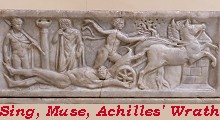 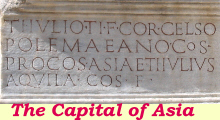 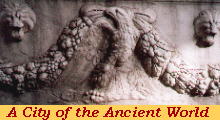 |
